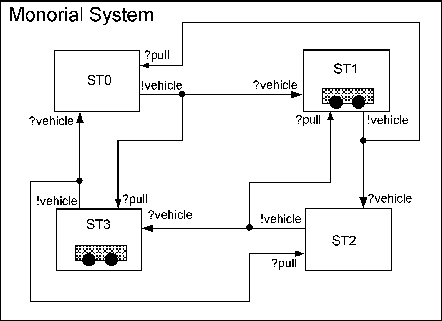 |
ST0, ST1, ST2 and ST3, respectively.
Each station, ST0, ST1, ST2 and ST3,
is an instance of Station class derived from Atomic
such that it has an input event set ![]() = {
= {?vehicle,
?pull} and an output event set ![]() ={
={!vehicle,
!pull} and two state variables: phase ![]() {Empty (
{Empty (E), Loading (L), Sending (S),
Waiting (W), Collided (C)}, and nso ![]() {false(
{false(f), true(t)} indicating ``next station is
NOT occupied'' for nso=f or ``next station is occupied''
for nso=t.
To avoid collisions that can occur when more than one vehicle
attempts to occupy a station (let's call it ![]() ) at the same time,
the station prior to
) at the same time,
the station prior to ![]() (let's call it
(let's call it ![]() ) should dispatch the
vehicle ONLY when
) should dispatch the
vehicle ONLY when ![]() 's nso =
's nso = f. The phase
transition diagram of a single station is shown in Figure
3.4 where an arc is augmented by
(pre-condition),(post-condition). For example, when a
station receives ?p at phase=E, it makes
nso=f; if phase=L and nso=f, then when it
receives ?p, it changes into phase=S internally
without any output indicated by !![]() . The symbols
. The symbols
?v, ?p, and !v in Figure 3.2 stand
for ?vehicle, ?pull, and !vehicle,
respectively.
The loading time ![]() is assigned as
is assigned as ![]() for
for ST0,
ST2, ST3; ![]() for
for ST1 (because ST1
is bigger than the rest other three stations). The initial state
for each station is
![]() for
for ST0 and
ST2,
![]() for
for ST1 and
ST3.
To model and simulate this monorail system, we build
Station as follows.